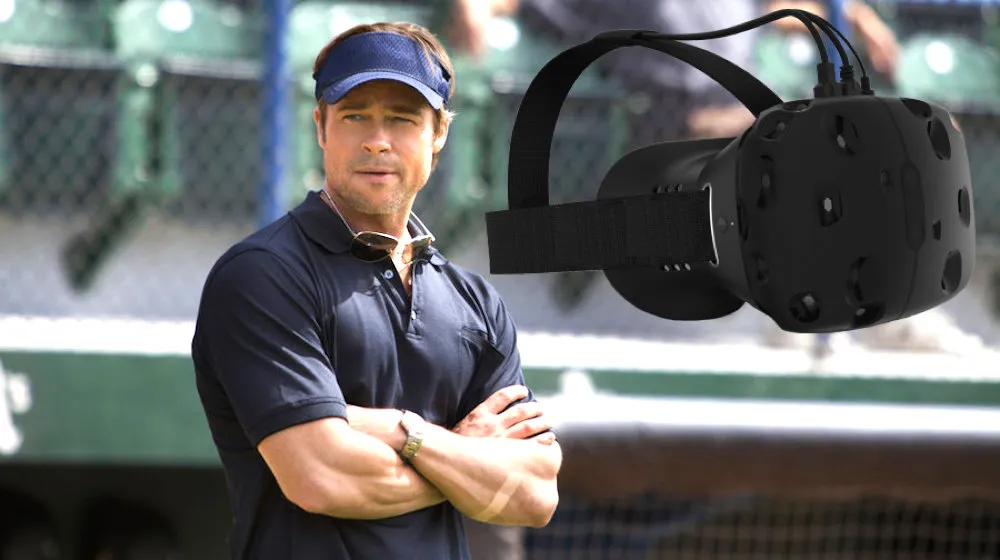Home run! Great hit! Awesome swing! These are words that I never heard during my short lived little league baseball career. However, if I had been able to access Trinity VR’s technology at the time, perhaps I would have.
Trinity VR is an ambitious new virtual reality company behind DiamondFX — an experience that combines the immersive power of the HTC Vive with the unending statistics of Major League Baseball. The result is a virtual pitching machine that can throw Justin Verlander’s fastball or Clayton Kershaw’s curve. I had the chance to try DiamondFX at the Upload offices in San Francisco and the results were that I struck out…a lot.
If you’ve ever wanted to know how difficult it is to hit a 90 mph fastball the answer is: very. DiamondFX uses an actual, wooden, regulation MLB bat with a jerry-rigged Vive controller on the handle to determine your position in the digital ballpark it has created. The software behind the experience then crunches a herculean amount of statistical information to create a pitcher that throws just like the professional pitcher of your choice. I chose Verlander and soon recognized the gravity of my mistake.
The digital ball whisked by me at lightning speeds without me laying so much as a grain of wood on the cowhide. I struck out again and again only to be eventually informed that the app wasn’t even set to true “professional” settings during my run. My handlers flipped that switch and then I could hardly even see the ball I was trying to hit. Professional baseball, it seems, will not be a part of my life story.
But DiamondFX may indeed be part of the story for a number of MLB franchises. According to Rahat Ahmed, co-founder and chief strategy officer for Trinity VR:
“We’re in discussions with a few MLB teams at the moment as we are actively looking for developmental partners. We know there’s still a lot to do, but we believe DiamondFX has the capability of being the next generation of Moneyball: Our goal isn’t just to help you fix your swing but to help teams draft better, sign free agents more intelligently and engage with fans more effectively. It’s an all-encompassing platform that uses VR as a foundational tool to deliver teams higher quality data in large volumes as to help coaches, executives, scouts and players to make the best decisions possible.
…The reception has been very solid. From what we know, we’re the only top-to-bottom solution where we’re not only recreating pitchers but also capturing high levels of data from the batter in one system. That allows us to tell more “complete” stories to aid predictive analysis. Ultimately, though, we actively listen to domain experts to continue to improve the product. “
From my perspective, DiamondFX is an impressive tool for batting practice and, according to Ahmed, the goal is to create an adversary for pro-batters that is indistinguishable from a real world pitcher:
The core of our tech is to replicate a professional pitcher—because those guys aren’t going to come to your team’s practice. We do this with a combination of taking in existing pitching data that Major League Baseball has tracked for nearly a decade and re-creating it within a game engine. We have an in-house custom physics engine that can now replicate most pitches to about 95% accuracy.
Trinity VR has kept DiamnondFX in stealth mode until recently but is now ready to begin unveiling it more significantly to the world. DiamondFX may be new but Trinity VR has been around for a while now. According to Ahmed:
For those who’ve followed the VR industry for a few years, our name probably rings a bell because we started off as a motion controller and tracking company. Back in 2014, we had a product called the Trinity Magnum that was a bit too early for its time. We followed that up in 2015 with a haptics-based shotgun for Starbreeze’s The Walking Dead VR Experience. But a year ago, as news was coming out regarding competing input and tracking, we looked at our expertise and asked ourselves, “How can we build something that goes beyond just interaction—what if we could capture data?” We have some in-house experience in data that allowed us to treat VR as a tool for creating low-cost simulations, an idea that we first decided to apply to professional baseball because we believed the market was sizable and the technology was ready.
Ahmed explained that Trinity VR has completed a successful round of “internal fundraising” but is now, “at the precipice of a much larger round…That being said, we want to get baseball right first. It’ll give us the credibility to move onto other sports/industries.”
Trinity VR will be showcasing DiamondFX further this week at CES 2017 in Las Vegas.





























